This Berry Chantilly Cake recipe is a delightful dessert that combines a tender and light white cake with a rich and creamy Chantilly Cream frosting and fresh seasonal berries. The perfect simple summer naked cake with pro cake baking tips and tricks!
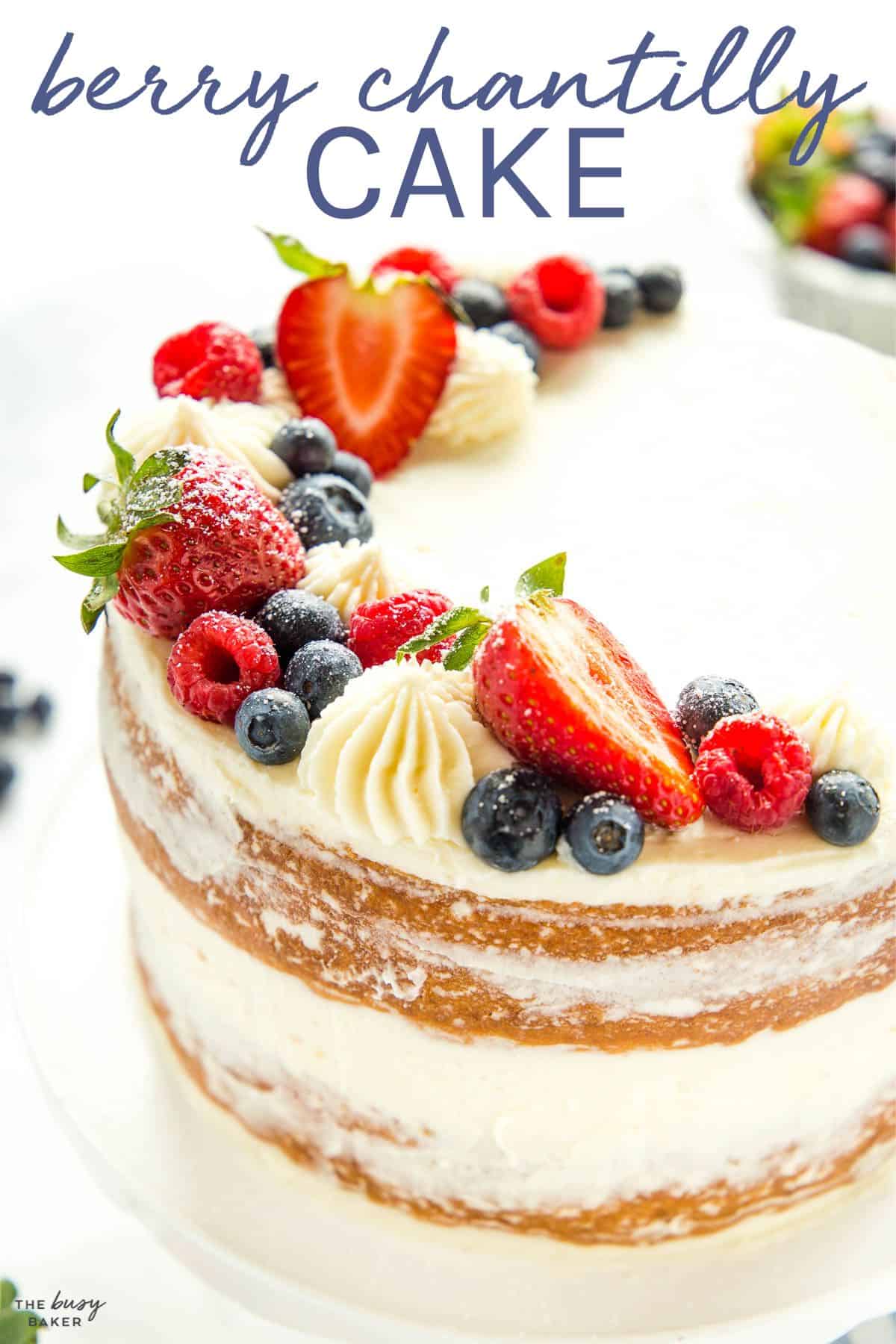
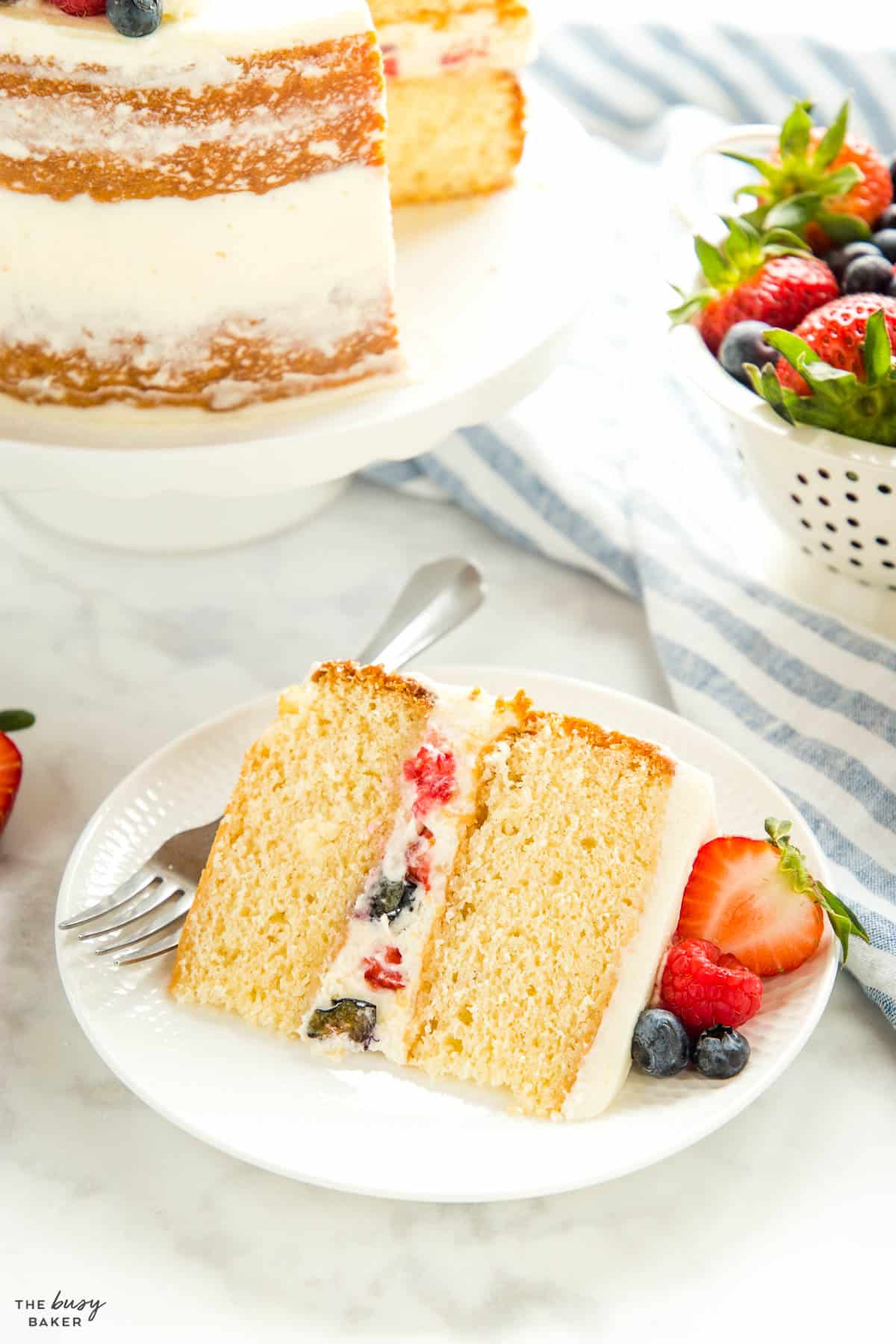
When it comes to spring and summer desserts, there’s nothing better than fresh berries and freshly whipped cream. This Berry Chantilly Cake recipe is tender and light, and it’s filled with fresh, juicy berries and sweet chantilly cream frosting.
We love this Chantilly cake recipe with fresh berries SO much because it’s not only full of delicious spring and summer flavours, it’s also one of the most beautiful desserts that’s as impressive as it is delicious.
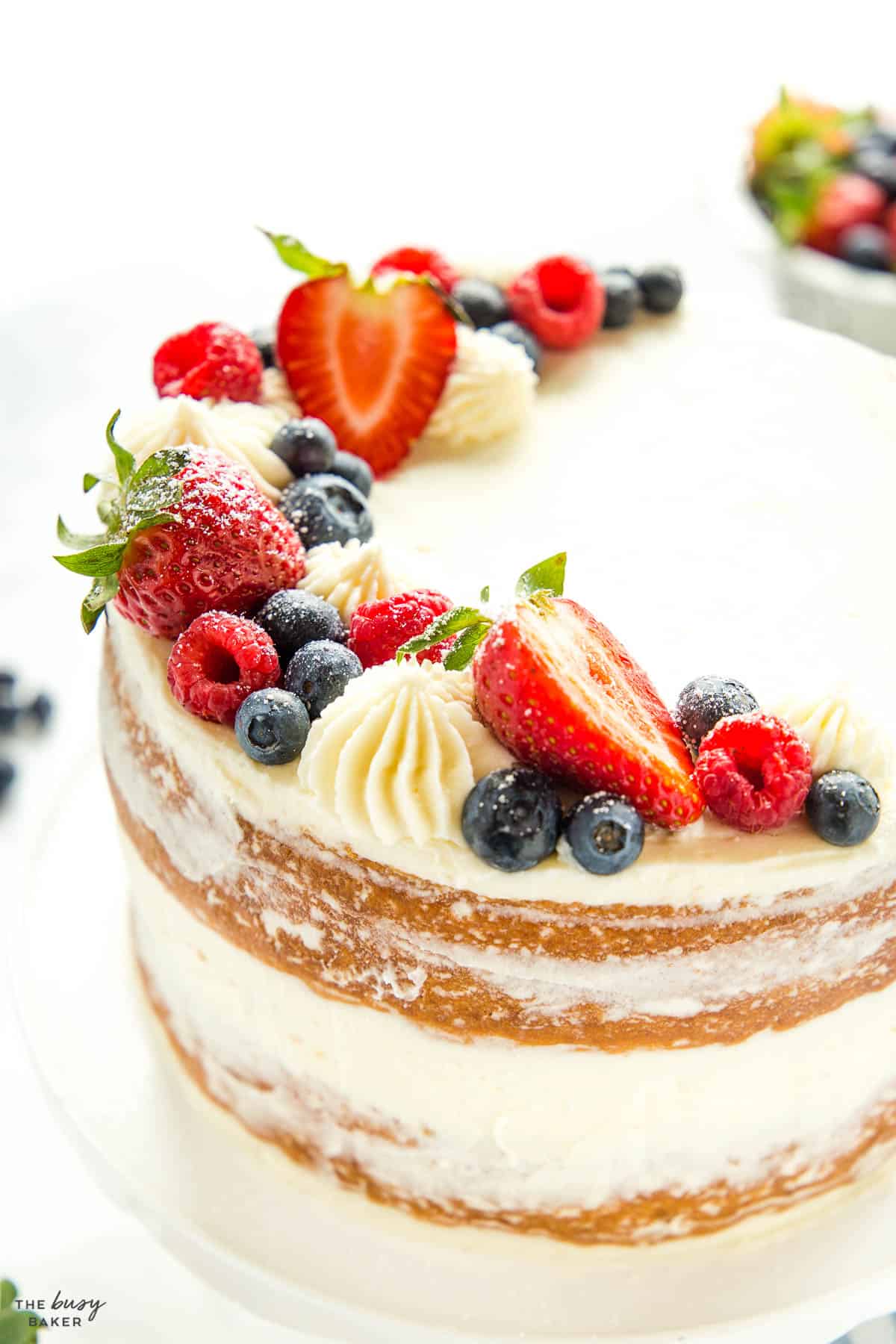
Berry Chantilly Cake is a dessert that’s common to the southern United States. It’s often made with layers of light vanilla-flavoured white sponge cake and frosted with a whipped cream-based Chantilly frosting made with mascarpone cheese. It’s filled and topped with freshly chopped strawberries, raspberries and blueberries, and it’s served on warm spring and summer days.
The name Chantilly comes from France, and it refers to traditional cream whipped to soft peaks. Although this Chantilly frosting contains mascarpone and isn’t exactly like the French Chantilly cream, it has a strong whipped cream flavour and texture which adds to the lightness of this dessert.
And as is true for most show-stopping desserts, this Berry Chantilly Cake is unbelievably simple: it’s just white cake, fresh berries and an easy whipped cream frosting. With a few easy-to-follow cake baking tips and tricks and our simple recipe, you’ll be well on your way to Chantilly cake heaven!
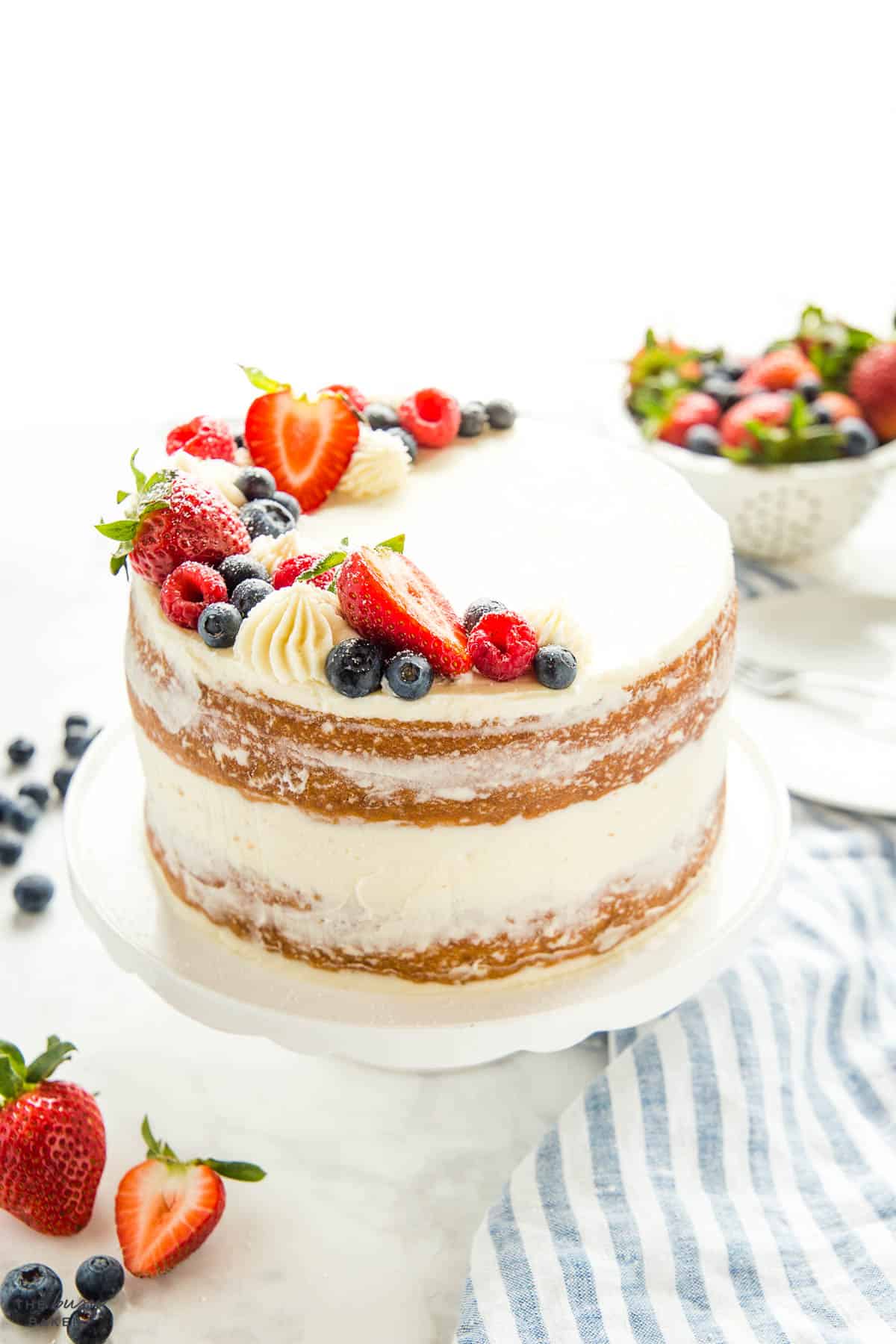
Here are all our BEST Pro Tips for baking a Berry Chantilly Cake from scratch!
- Start with room-temperature ingredients. Make sure your milk and eggs are at room temperature. This will create a smooth cake batter and help the ingredients combine properly.
- Measure the flour correctly. The best way to measure flour is in grams, but if you’re using cup measurements be sure to fluff the flour in its bag or container before scooping VERY gently (don’t pack the flour into the measuring cup at all), and then level it off with the back of a knife or other flat object.
- Avoid over-mixing, especially after adding the flour. Over-mixing can create a dry, tough cake because it reduces the number of air bubbles present in the batter which give the cake its lift as it bakes.
- Don’t mix on high speed. This can create something called tunnelling where long, thin air bubbles appear in the baked cake. This is caused by vigorous mixing that strengthens the gluten strands in the cake batter too much.
- Prepare the pans properly. Always grease your cake pans generously with butter and dust the inside with cocoa powder on all sides (use flour if you’re making a white cake and cocoa powder for a chocolate one). This will prevent the cake from sticking to the pan. We suggest using spring-form pans for baking cakes for even easier removal.
- Bake immediately after mixing. Don’t let an unbaked cake sit out on the counter. Always preheat your oven first and bake the cake immediately after adding the batter to the pans. This will help the cake rise properly in the oven as the leavening agent in the cake batter is activated as soon as the wet and dry ingredients are combined.
- Place the pans in the centre of the oven. Don’t place the pans too close together as this can cause them to brown too much on one side. Add the pans to the centre of the oven so they bake evenly.
- Don’t open the oven as they bake. Avoid opening the oven during baking unless it’s absolutely necessary to rotate the cakes while baking (if your oven is small or has a hot spot). Opening the oven door at the end of the baking time is ok, especially because testing the cake with a toothpick is necessary to prevent over-baking.
- Don’t over bake. Over-baked cakes are dry and crumbly. Be sure to remove them from the oven as soon as a toothpick inserted into the top of the cake comes out clean.
- Don’t under bake. Under-baked cakes are partly baked but gummy on top and in the centre. Test the cake with a toothpick to be sure the cake is baked completely.
- Don’t let them cool completely in the pan. Cool the cakes in the pan only for the first 10-20 minutes of cooling, then turn them out onto a cooling rack to cool completely. Cooling the cakes in the pan will trap moisture in and make them soggy.
- Frost only after completely cooled. Don’t try to frost a cake that’s still warm, especially if you’re using a butter-based frosting as the butter will melt and you’ll be left with a mess. Wait for the cakes to cool completely, then frost.
- Level the cakes before frosting, if necessary. Use a large serrated knife (like a bread knife) to cut any domed top off of the cakes before assembling and frosting.
- Chill the cake during assembly. Add whatever filling you’re using between the layers, then chill for 20-30 minutes in the fridge. This will help the filling firm up so the cake keeps its shape as you add the frosting around the outside of the cake.
- Chill the cake before slicing. Place the cake in the fridge once you’ve finished frosting it so the frosting can firm up. This will make the cake easier to slice and create clean, uniform slices.
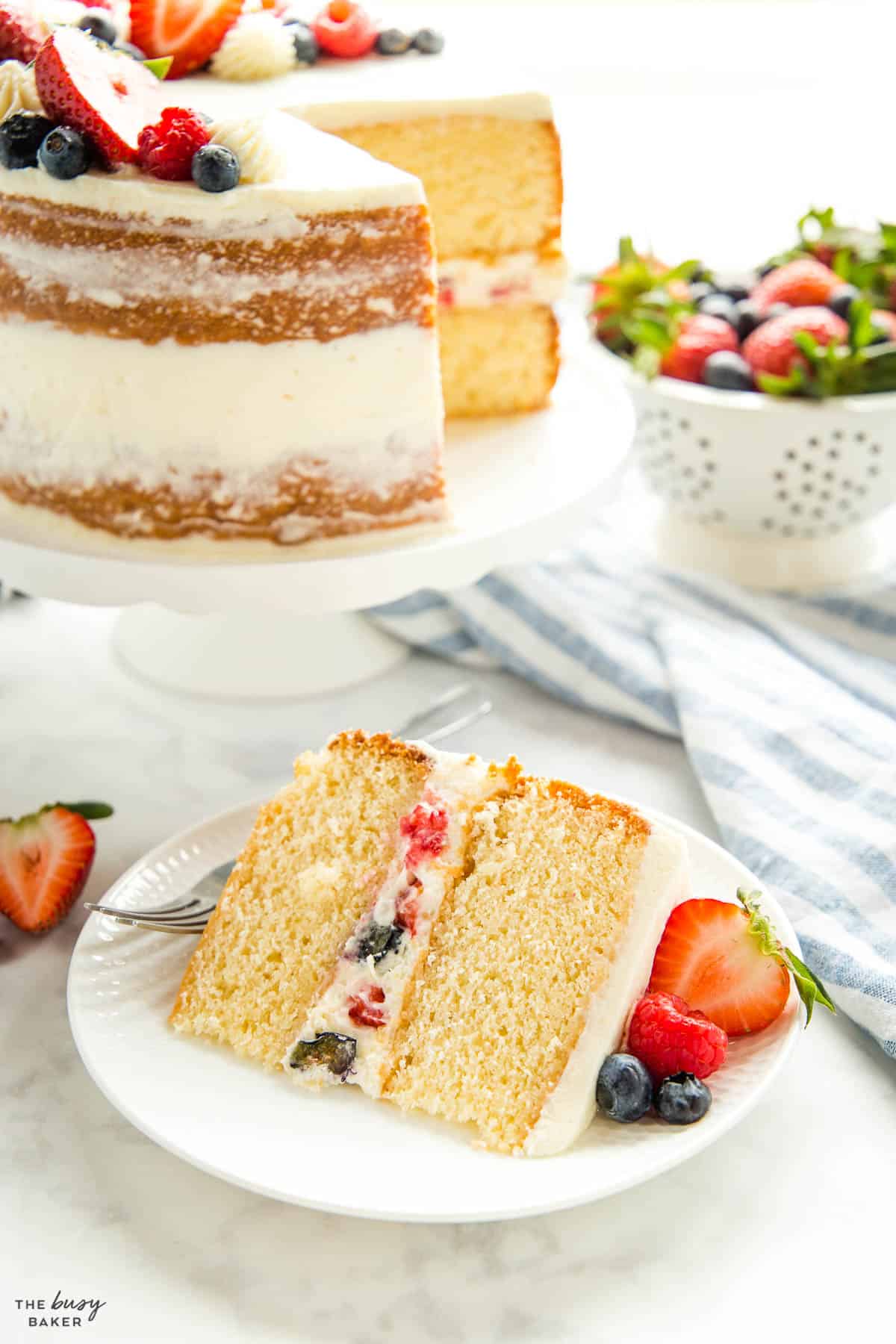
Here are some common problems you might encounter while baking layer cakes and how to prevent them:
- An uneven or sunken cake:
- Make sure to measure ingredients accurately, especially the leavening agents like baking powder or baking soda.
- Do not over-mix the batter as this can result in excess air being incorporated into the batter, leading to uneven baking and sinking in the centre of the cakes.
- Ensure the oven is preheated to the correct temperature before placing the cake inside.
- Avoid opening the oven door during baking as this can cause major changes in oven temperature and result in an uneven rise.
- A dry or dense cake:
- Measure the flour properly by spooning it into the measuring cup and levelling it off, rather than scooping it directly from the bag (using the fluff and scoop method also works well).
- Do not over-mix the batter as this can over-develop gluten in the batter and lead to a tougher texture. Mix until the ingredients are just combined and the flour disappears.
- Check the baking time and temperature. Over-baking can cause the cake to dry out. Use a toothpick to check for doneness.
- A cracked cake:
- An oven temperature that’s too high can cause the cake to rise too quickly and crack on the surface. Double-check that your oven temperature is correct by using an oven thermometer.
- Avoid opening the oven door during the first half of baking. This can cause sudden temperature changes that contribute to cracking on the top of the cake.
- Cakes that stick to the pan:
- Properly grease and flour the cake pans (dust with cocoa powder instead of flour for a chocolate cake). You can also use parchment paper to line the bottoms of the pans to prevent sticking.
- Allow the cake to cool in the pan for 10, 15 or even 20 minutes before inverting it onto a wire rack. Cooling the layers in the pan for several minutes helps the cake release more easily.
- Sunken cake layers:
- Check the freshness of your baking powder or baking soda. They lose potency over time and can cause cakes to sink. Replace them if necessary.
- Ensure the oven temperature is accurate. Use an oven thermometer to check the temperature.
- Avoid over-mixing the batter, as this can deflate the air incorporated during the creaming process. Mix until just combined.
- Be sure the cakes are fully baked before removing them from the oven. If they’re not fully baked in the centre, they’ll sink in the middle after you remove them from the oven.
- Difficulty frosting the cake:
- Be sure the texture of your frosting is soft enough that it will easily glide over the surface of the cake without difficulty.
- It’s a good idea to refrigerate the cake layers before frosting to make frosting the cake easier (the layers will be firmer after refrigerating).
- The cake is bulging on the sides or difficult to slice:
- Refrigerate the cake after placing the frosting between the layers and before frosting the outside of the cake. This will prevent the cake from settling too much and the sides from bulging.
- If the cake is difficult to slice because it’s too soft, refrigerate for 30 minutes to an hour before slicing.

If you’re looking for more delicious desserts for summer we have SO many recipes you’re going to love. Here are some of our favourites:
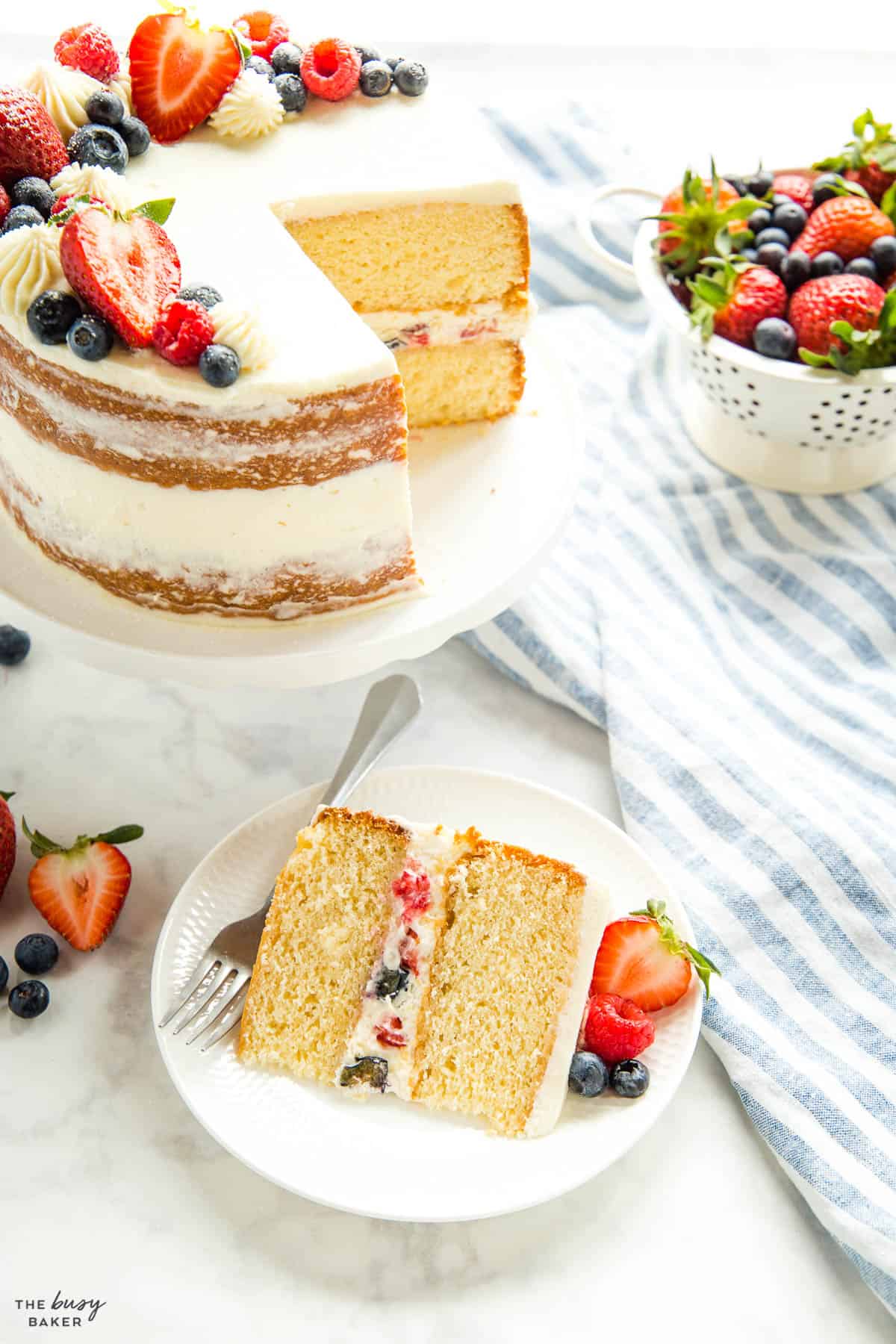
And there’s even more where that came from. We’ve compiled all our favourite summer desserts in our Summer Desserts e-book, available NOW in The Busy Baker Shop!
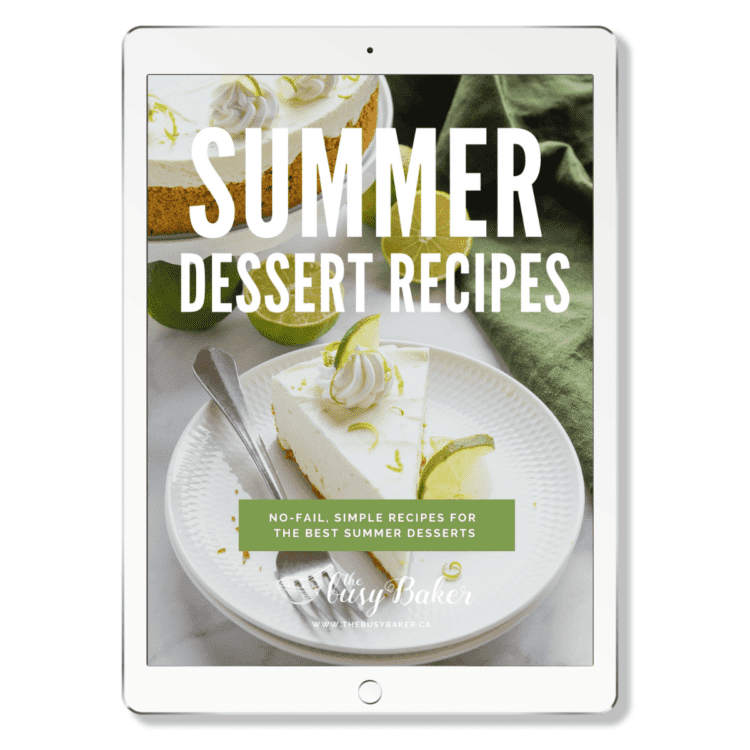
EASY AND DELICIOUS SUMMER DESSERT RECIPES YOU’LL LOVE!
Get my no-fail summer dessert recipes e-cookbook!
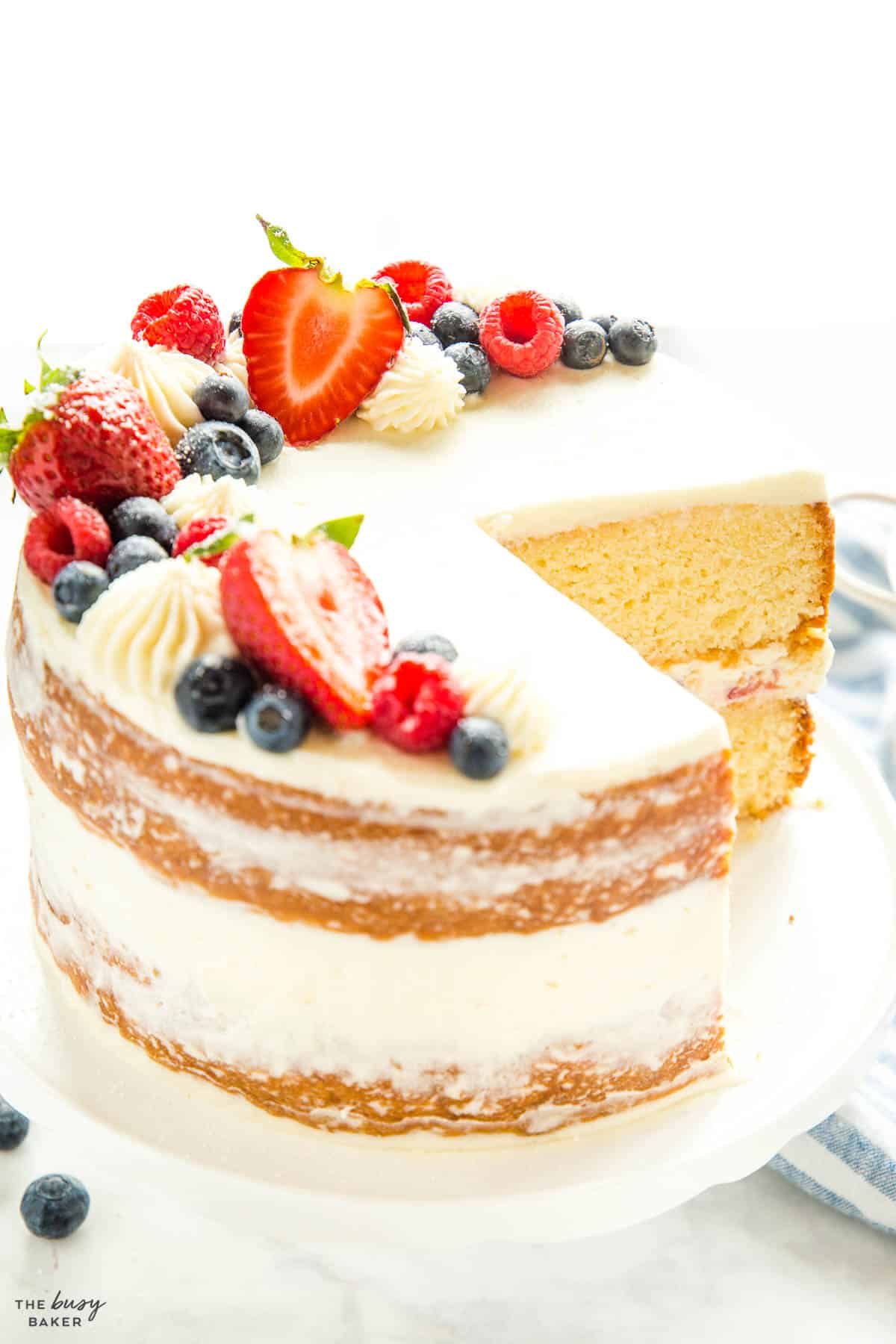
To make this cake recipe you’ll need (affiliate links):
- a stand mixer or a hand mixer with some mixing bowls
- measuring cups and spoons for dry ingredients
- measuring cups for liquid ingredients
- a silicone spatula
- a whisk
- 8-inch round cake pans or 9-inch round cake pans
- an offset spatula
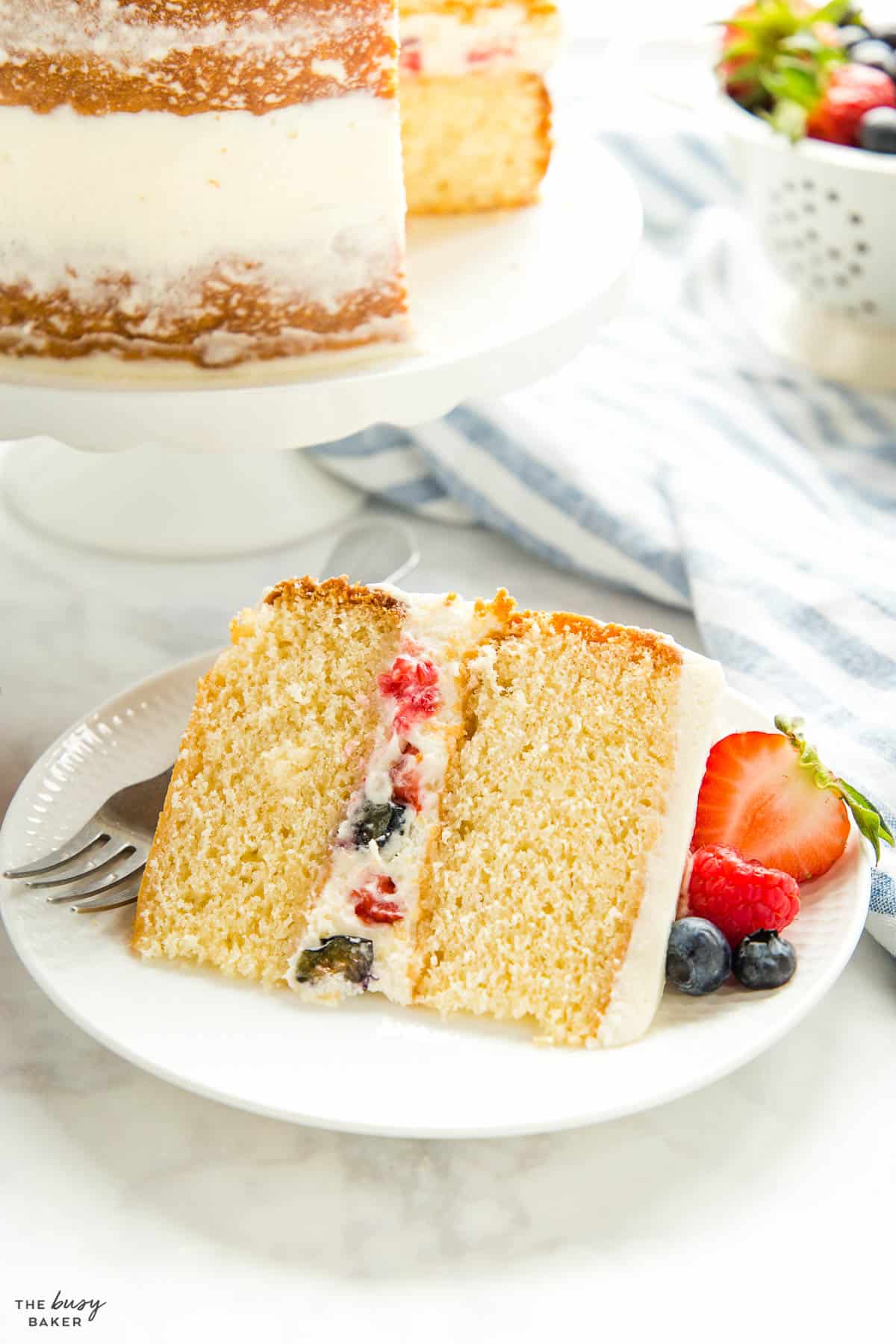
Here is a list of the ingredients you’ll need to make this Berry Chantilly Cake recipe:
- butter and flour for preparing the cake pans
- unsalted butter
- eggs
- egg yolks
- buttermilk
- vegetable oil
- all purpose flour
- baking powder
- baking soda
- salt
- cream cheese
- mascarpone cheese
- heavy whipping cream
- powdered sugar
- strawberries
- raspberries
- blueberries
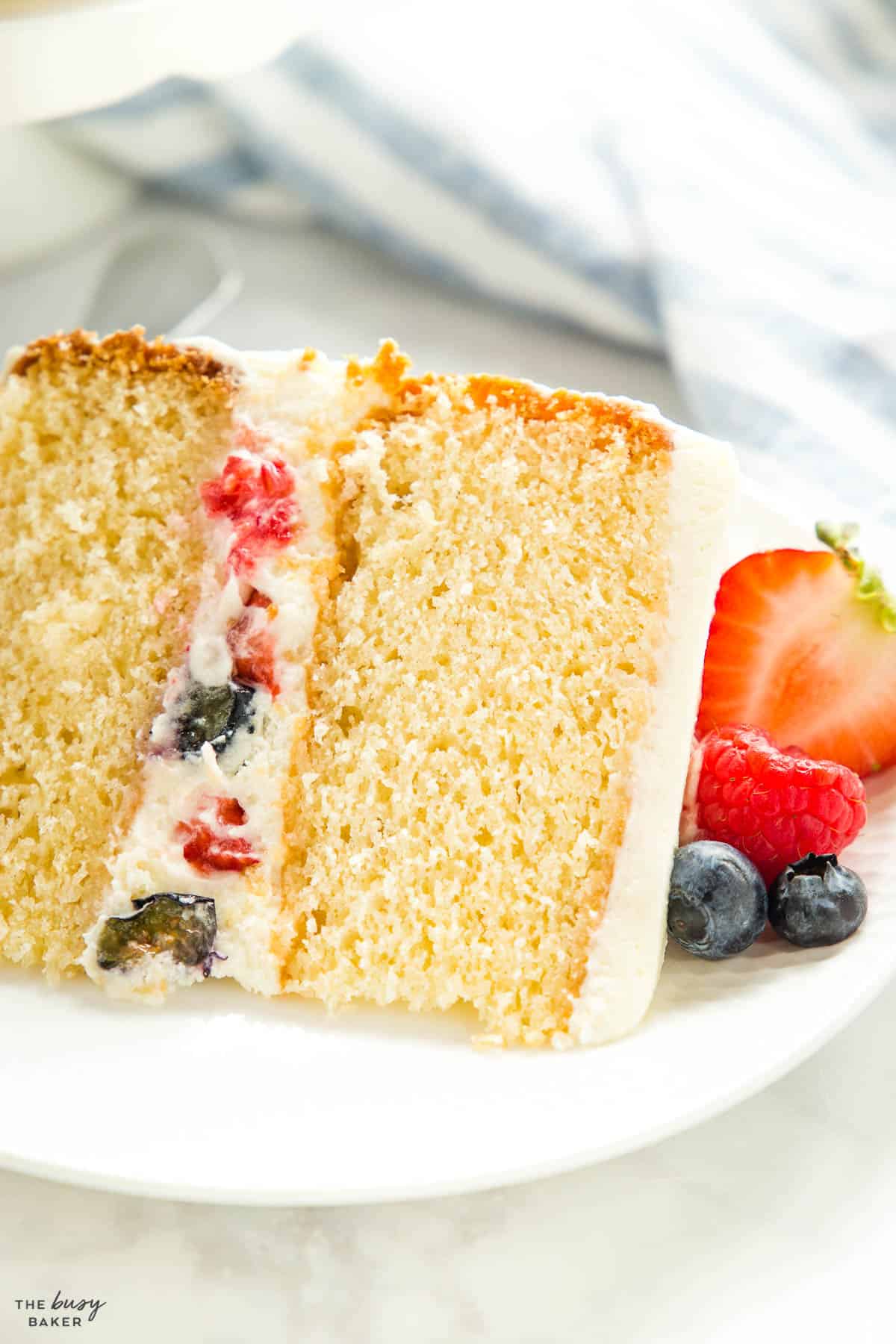
Try one of these variations on the classic Berry Chantilly Cake recipe!
- Lemon: Add a touch of lemon zest and juice to the cake batter for a refreshing twist.
- Chocolate: Incorporate cocoa powder into the cake batter and frost with Chantilly cream flavoured with a hint of chocolate.
- Tropical: Substitute some of the fresh berries with tropical fruits like mango, pineapple, and kiwi, and add some shredded coconut on top for a tropical flavour explosion.
- Mixed Berry: add blackberries, red and black currants, cranberries, and any other berries you can get your hands on for a more colourful and flavourful berry Chantilly cake.

Time needed: 2 hours
Follow these steps for the perfect Berry Chantilly Cake recipe!
- Prepare the cake pans first.
It’s important to bake the cakes right after combining the wet and dry ingredients, so start by preheating your oven and preparing the cake pans first.
- Cream the butter and sugar well.
Mixing the butter and sugar very well gives the cake structure and helps the batter become smooth, making sure the ingredients combine evenly.
- Add the milk and dry ingredients alternatively.
This helps the liquid become absorbed properly into the batter and creates a smooth cake batter.
- Cool the cakes before frosting.
Frosting a cake while it’s still warm will cause the frosting to melt. Prepare the frosting when the cakes are cool and frost only after they have cooled completely.
- Use fresh berries, not frozen.
Frozen berries will bleed their juices all over the cake, creating a messy appearance. It’s best to use fresh strawberries, raspberries and blueberries for this recipe.
- Level the cakes before frosting.
If your cakes have domed at all while baking, slice off the domed part to level the cakes. This will make the assembly of the layer cake a lot easier.
- Decorate with fresh berries.
A classic berry Chantilly cake has berries between the layers and also on top for a gorgeous presentation.
- Chill the cake before slicing.
Layer cakes slice so much more thinly if you chill them first to let the frosting firm up.

Can I use frozen berries for chantilly cake?
No, we don’t recommend this as frozen berries release a lot of juices that will colour the cake and the frosting. For the fresh, clean appearance of a true berry Chantilly cake, use fresh berries.
Why is my chantilly cake dry?
Dry cakes are usually over-baked or they contain too much flour and not enough liquid. Be sure to observe the baking time provided in the recipe (and be sure your oven is the correct temperature) and measure the flour properly.
What size cake pan can I use for this recipe?
You can bake this cake recipe in two 8-inch cake pans or two 9-inch cake pans. If you use 9-inch cake pans, you may have to reduce the baking time by 2-4 minutes since they cakes won’t be as thick. Be sure to test the cakes with a toothpick to be sure they’re done.
How to store berry chantilly cake?
Store the cake in the fridge for 3-5 days or until ready to serve (let sit out at room temperature for 15 minutes before slicing to let the frosting relax).
How to freeze berry chantilly cake?
You can freeze this cake frosted or unfrosted for up to 3 months, wrapped well in plastic wrap and in an airtight container or freezer bag to protect it from freezer burn. Thaw in the fridge overnight and allow to sit at room temp for 15-20 minutes before serving. We recommend adding the fresh berries on top right before serving.

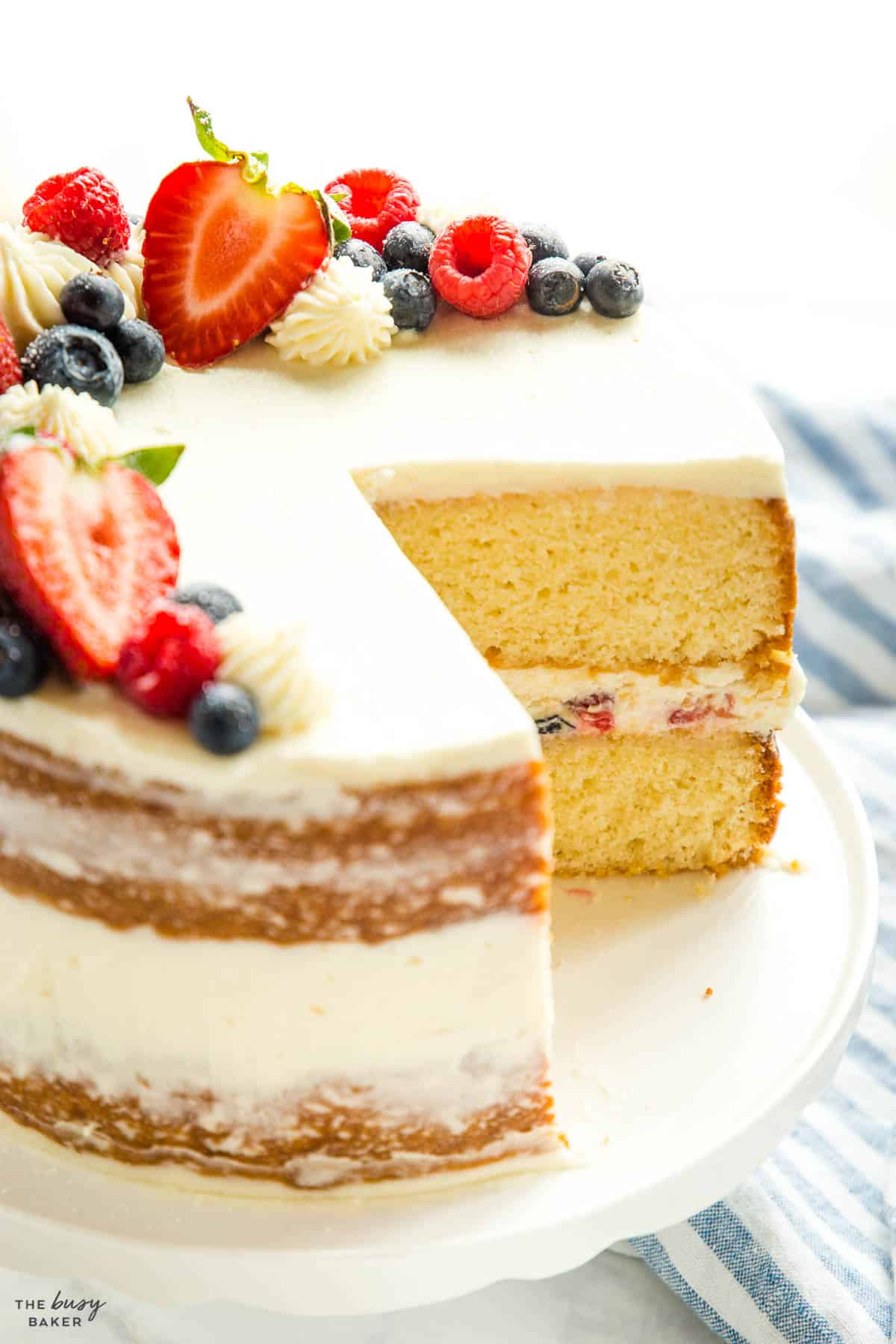
We hope you enjoy this berry cake recipe as much as we do! Let us know in the comments below, what’s your favourite summer cake recipe? We’d love to know!
If you made this, share a photo!
Are you trying this recipe? Use the comment form below to share your take; now with support for image uploads and comment voting!
Berry Chantilly Cake
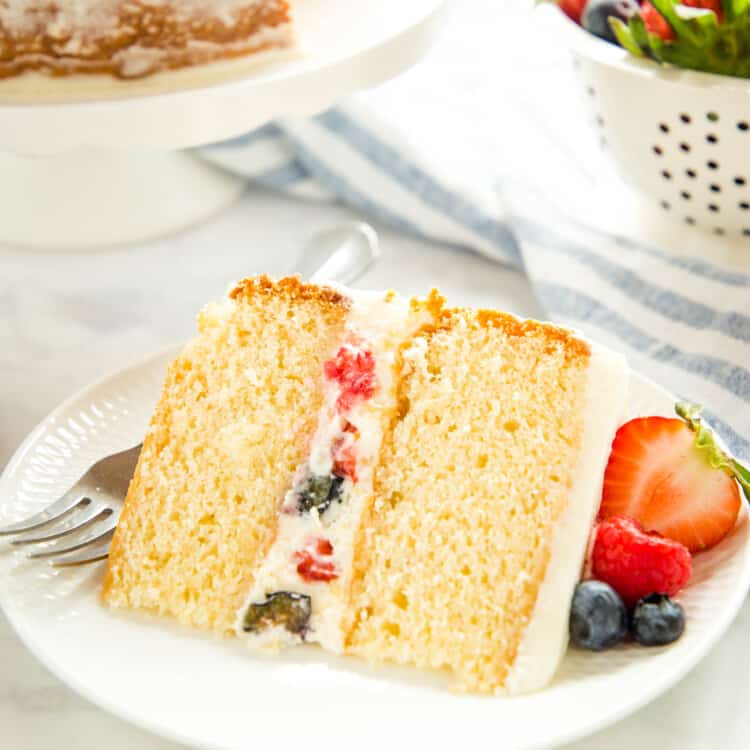
Recipe: Equipment
- Stand Mixer or Hand Mixer
Recipe: Ingredients
For the cake:
- 1-2 tablespoons each, butter and flour for preparing the cake pans
- 1 cup unsalted butter softened to room temperature
- 2 cups granulated sugar
- 3 eggs at room temperature
- 3 egg yolks at room temperature
- 1 1/4 cup buttermilk at room temperature
- 3 tablespoons vegetable oil
- 3 1/4 cups all purpose flour
- 1 tablespoon baking powder
- 1 1/2 teaspoons baking soda
- 1 teaspoon salt
For the frosting:
- 1/2 cup cream cheese plain, full fat, at room temperature
- 1/2 cup butter
- 1 cup mascarpone Cheese
- 1 cup heavy whipping cream or 2 cups whipped
- 2 cups powdered sugar sifted to remove lumps
- a pinch of salt
To assemble:
- 1/2 cup fresh strawberries
- 1/2 cup raspberries
- 1/2 cup blueberries
- more berries for topping and decorating the cake
Recipe: Instructions
For the cake:
- Grease and flour two 9-inch round cake pans (with high sides), lining the bottoms with parchment paper rounds for easy release.
- In the bowl of your stand mixer (or in a large bowl using a hand mixer), whip the butter on medium high speed until very smooth. Add the sugar and mix on high speed until fluffy and creamy. The sugar will start to dissolve into the butter a little bit during this creaming process, so you should be able to feel the grains of sugar getting smaller.
- Add the eggs and egg yolks one at a time, mixing well after each addition. Scrape down the sides of the bowl regularly at this stage to make sure everything is mixed well.
- Mix in the oil on low speed.
- Measure the buttermilk into a liquid measuring cup and and set aside.
- Measure and sift the flour, baking powder, baking soda and salt into a separate bowl and combine with a wire whisk.
- Add the dry ingredients and the buttermilk alternatively while the mixer is running on low speed. Add 1/3 of the dry ingredients, half the milk, another 1/3 of the dry ingredients, the other half of the milk, and the remaining dry ingredients.
- Turn the speed of the mixer to medium-low and mix until the batter is smooth (about one minute).
- Pour the batter into the prepared cake pans and bake at 325 degrees Fahrenheit for about 29-34 minutes or until a toothpick inserted into the middle of one of the cakes comes out clean.
- Cool the cakes in the pans for about 5-7 minutes and then turn them out onto cooling racks to cool completely.
- Once the cakes are cool, store them wrapped in plastic wrap in the fridge until ready to frost. They should be refrigerated for at least 1 hour before frosting.
For the frosting:
- Beat the butter, mascarpone and cream cheese together on high speed until light, fluffy and smooth.
- Sift the powdered sugar and slowly add it, one cup at a time, mixing after each addition. Add the salt and mix until incorporated.
- Add the whipped heavy cream and fold it in with a spatula until incorporated. The mixture should have a spreadable consistency but it should feel lighter and fluffier than traditional buttercream frosting.
Assembly:
- Wash and dry the berries. Cut the strawberries to be roughly the size of the other berries.
- Trim the cakes (if necessary) to level them, using a serrated knife. Place one cake, right side up, on a plate or cake board.
- Add a large dollop of frosting on top and spread it out to reach the edges of the cake. With a piping bag, create a small border on the edge. Add the mixed berries in the space created by the border and press them slightly in the cream. Smooth out the border towards the middle over the berries. Place the other cake on top of the frosting, upside down so the flat side faces up.
- Add your remaining frosting to the top of the cake and spread it over the top and down the sides of the cake, making sure to smooth it out to fill in any holes or cracks in the cake. You want to create a very smooth edge but still be able to see the layers.
- Decorate the top of the cake with extra berries.
- Place the cake in the fridge to chill for about 30-45 minutes so that the frosting can firm up before slicing.
Recipe: Notes
Storage Instructions
Store the cake in the fridge until ready to serve (let sit out at room temperature for 15 minutes before slicing to let the frosting relax).Make Ahead Instructions
To make this cake ahead of time, simply prepare as directed in the recipe and store it in the fridge for up to 2 days before serving. We recommend decorating the top of the cake right before serving, or on the day you plan to serve it.Freezer Instructions
To freeze this cake, we recommend freezing the cake layers before frosting. Simply wrap them in plastic wrap or store them in an airtight container or freezer bag. Defrost before frosting, assembling the cake, and serving.Recipe: Nutrition
Notice: Nutrition is auto-calculated, using Spoonacular, for your convenience. Where relevant, we recommend using your own nutrition calculations.

EASY AND DELICIOUS SUMMER DESSERT RECIPES YOU’LL LOVE!
Get my no-fail summer dessert recipes e-cookbook!
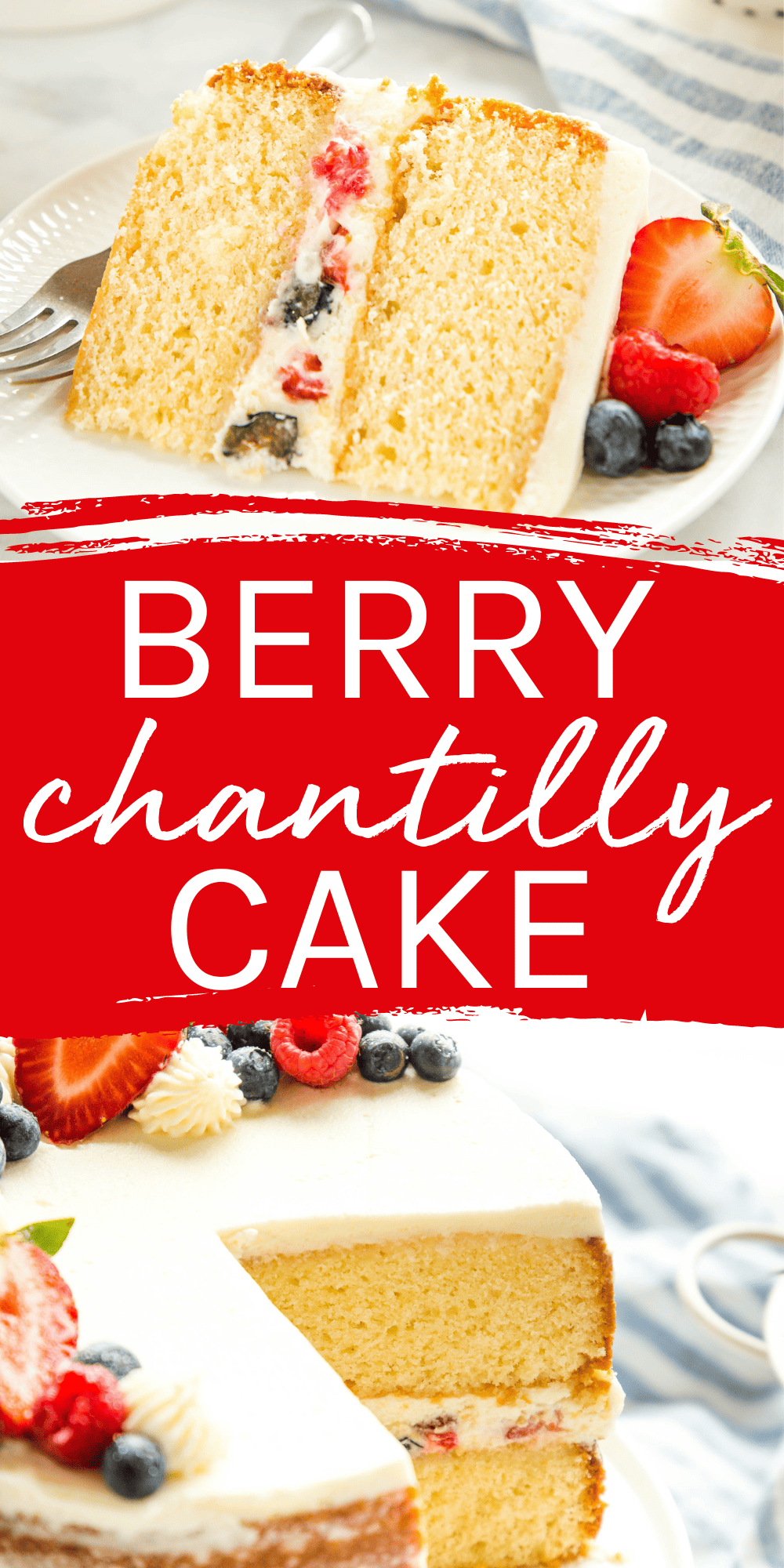

I’m planning to bake this for my niece’s graduation. Do you recommend using buttercream on the outside to seal in the cream and berries for a tiered cake? It will be sitting out from the afternoon into the evening and I’m worried it will start to flatten out. I was planning to make 3 of the 8″ round for the bottom tier, then 3 of the 5″ round for the top tier.
Also, I bought some cake safe discs and was going to try this out. Will this flip okay with all the weight and berries if I freeze it for 30 minutes? I read to frost the cake upside down to get crisp edges.
Yes, sounds like buttercream is your best bet. Yes, feel free to freeze it for 30 minutes and turn it. Let us know how it turns out, we’d love it if you shared a picture with us!